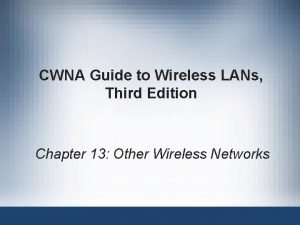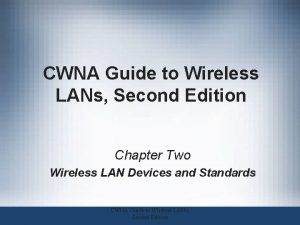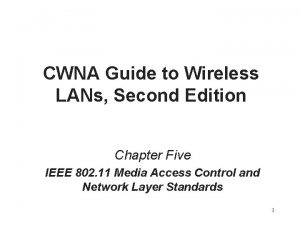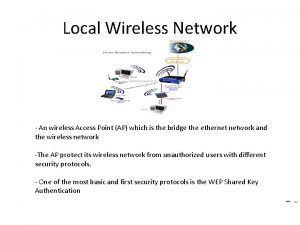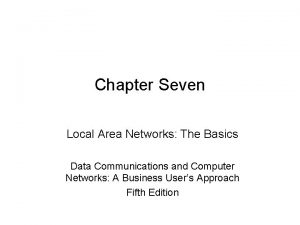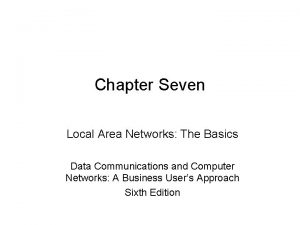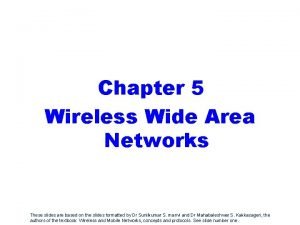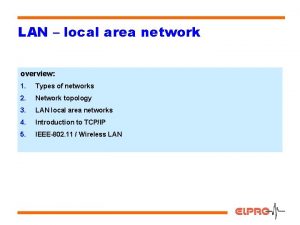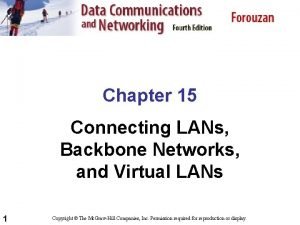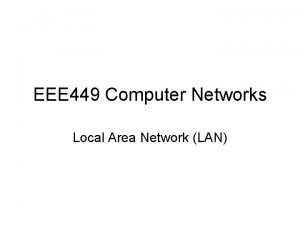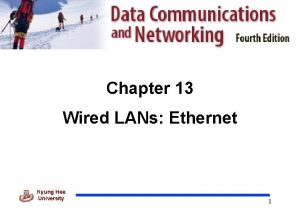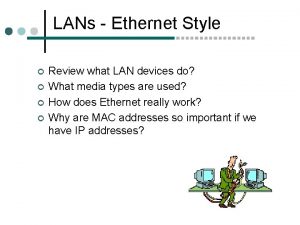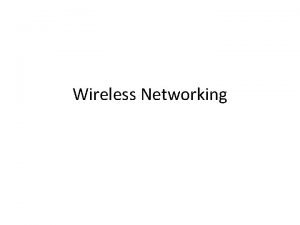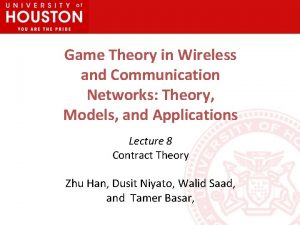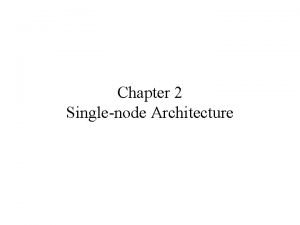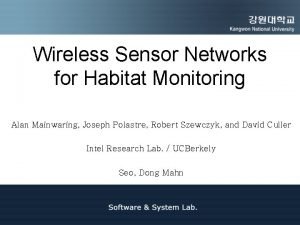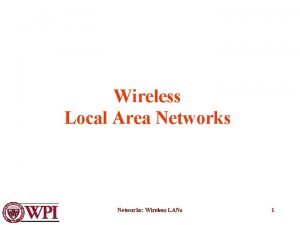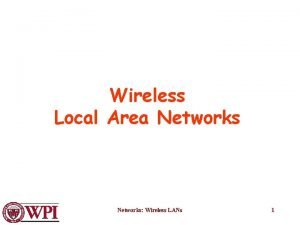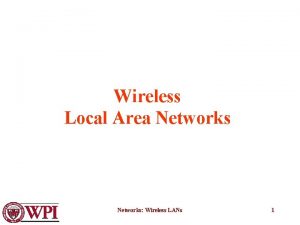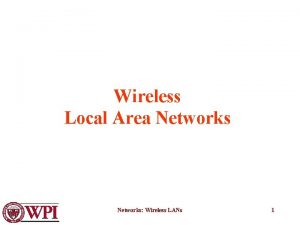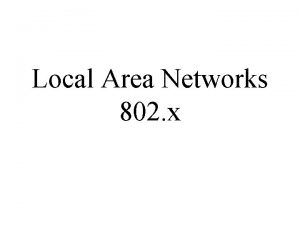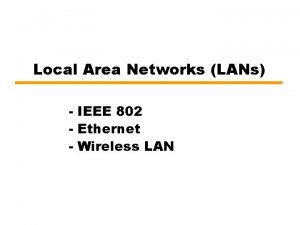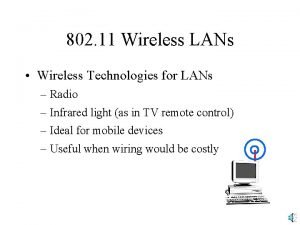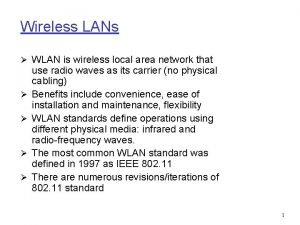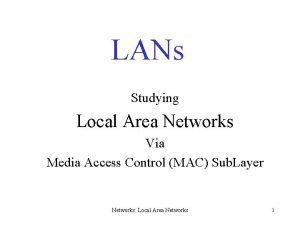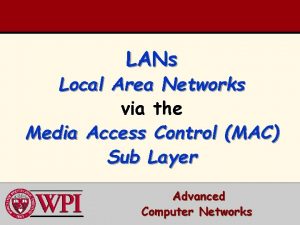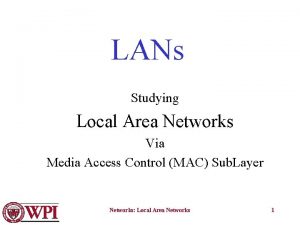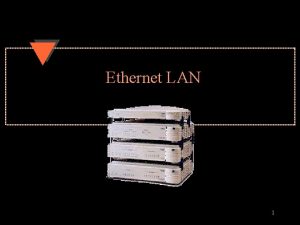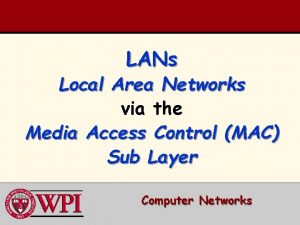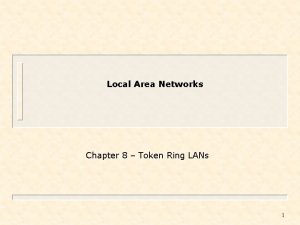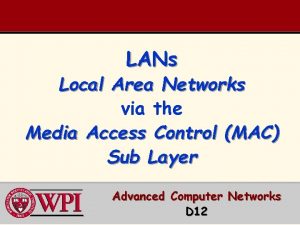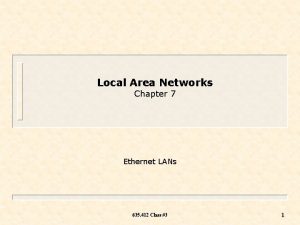Wireless Local Area Networks Wireless LANs 1 Wireless























- Slides: 23

Wireless Local Area Networks: Wireless LANs 1

Wireless Local Area Networks • The proliferation of laptop computers and other mobile devices (PDAs and cell phones) created an obvious application level demand for wireless local area networking. • Companies jumped in, quickly developing incompatible wireless products in the 1990’s. • Industry decided to entrust standardization to IEEE committee that dealt with wired LANS – namely, the IEEE 802 committee!! Networks: Wireless LANs 2

IEEE 802 Standards Working Groups Figure 1 -38. The important ones are marked with *. The ones marked with are hibernating. The one marked with † gave up. Networks: Wireless LANs 3

Categories of Wireless Networks • Base Station : : all communication through an access point {note hub topology}. Other nodes can be fixed or mobile. • Infrastructure Wireless : : base station network is connected to the wired Internet. • Ad hoc Wireless : : wireless nodes communicate directly with one another. • MANETs (Mobile Ad Hoc Networks) : : ad hoc nodes are mobile. Networks: Wireless LANs 4

Wireless LANs Figure 1 -36. (a) Wireless networking with a base station. (b) Ad hoc networking. Networks: Wireless LANs 5

The 802. 11 Protocol Stack Figure 4 -25. Part of the 802. 11 protocol stack. Networks: Wireless LANs 6

Wireless Physical Layer • Physical layer conforms to OSI (five options) – 1997: 802. 11 infrared, FHSS, DHSS – 1999: 802. 11 a OFDM and 802. 11 b HR-DSSS – 2001: 802. 11 g OFDM • 802. 11 Infrared – Two capacities 1 Mbps or 2 Mbps. – Cannot penetrate walls. • 802. 11 FHSS (Frequence Hopping Spread Spectrum) – 79 channels, each 1 Mhz wide at low end of 2. 4 GHz ISM band. – Same pseudo-random number generator used by all stations. – Dwell time: min. time on channel before hopping (400 msec). Networks: Wireless LANs 7

Wireless Physical Layer • 802. 11 DSSS (Direct Sequence Spread Spectrum) – Spreads signal over entire spectrum using pseudo-random sequence (similar to CDMA see Tanenbaum sec. 2. 6. 2). – Each bit transmitted as 11 chips (Barker seq. ), PSK at 1 Mbaud. – 1 or 2 Mbps. • 802. 11 a OFDM (Orthogonal Frequency Divisional Multiplexing) – – – Compatible with European Hiper. Lan 2. 54 Mbps in wider 5. 5 GHz band transmission range is limited. Uses 52 FDM channels (48 for data; 4 for synchronization). Encoding is complex ( PSM up to 18 Mbps and QAM above this capacity). E. g. , at 54 Mbps 216 data bits encoded into 288 -bit symbols. More difficulty penetrating walls. Networks: Wireless LANs 8

Wireless Physical Layer • 802. 11 b HR-DSSS (High Rate Direct Sequence Spread Spectrum) – – 11 a and 11 b shows a split in the standards committee. 11 b approved and hit the market before 11 a. Up to 11 Mbps in 2. 4 GHz band using 11 million chips/sec. Note in this bandwidth all these protocols have to deal with interference from microwave ovens, cordless phones and garage door openers. – Range is 7 times greater than 11 a. – 11 b and 11 a are incompatible!! Networks: Wireless LANs 9

Wireless Physical Layer • 802. 11 g OFDM(Orthogonal Frequency Division Multiplexing) – Supports 54 Mbps. – Uses 2. 4 GHz frequency for greater range. Networks: Wireless LANs 10

802. 11 MAC Sublayer Protocol • In 802. 11 wireless LANs, “seizing channel” does not exist as in 802. 3 wired Ethernet. • Two additional problems: – Hidden Terminal Problem – Exposed Station Problem • To deal with these two problems 802. 11 supports two modes of operation DCF (Distributed Coordination Function) and PCF (Point Coordination Function). • All implementations must support DCF, but PCF is optional. Networks: Wireless LANs 11

Figure 4 -26. (a)The hidden station problem. (b) The exposed station problem. Networks: Wireless LANs 12

The Hidden Terminal Problem • Wireless stations have transmission ranges and not all stations are within radio range of each other. • Simple CSMA will not work! • C transmits to B. • If A “senses” the channel, it will not hear C’s transmission and falsely conclude that A can begin a transmission to B. Networks: Wireless LANs 13

The Exposed Station Problem • The inverse problem. • B wants to send to C and listens to the channel. • When B hears A’s transmission, B falsely assumes that it cannot send to C. Networks: Wireless LANs 14

Distribute Coordination Function (DCF) • Uses CSMA/ CA (CSMA with Collision Avoidance). – Uses both physical and virtual carrier sensing. – Two methods are supported: 1. based on MACAW with virtual carrier sensing 2. 1 -persistent physical carrier sensing. Networks: Wireless LANs 15

Wireless LAN Protocols • MACA protocol solved hidden, exposed terminal: – Send Ready-to-Send (RTS) and Clear-to-Send (CTS) first – RTS, CTS helps determine who else is in range or busy (Collision avoidance). – Can a collision still occur? Professor Agu’s slide Networks: Wireless LANs 16

Wireless LAN Protocols • MACAW added ACKs and CSMA (no RTS at same time) (a) A sending an RTS to B. (b) B responding with a CTS to A. Professor Agu’s slide Networks: Wireless LANs 17

Virtual Channel Sensing in CSMA/CA Figure 4 -27. The use of virtual channel sensing using CSMA/CA. • C (in range of A) receives the RTS and based on information in RTS creates a virtual channel busy NAV. • D (in range of B) receives the CTS and creates a shorter NAV. Networks: Wireless LANs 18

Figure 4 -28. Fragmentation in 802. 11 • High wireless error rates long packets have less probability of being successfully transmitted. • Solution: MAC layer fragmentation with stop-andwait protocol on the fragments. Networks: Wireless LANs 19

1 -Persistent Physical Carrier Sensing • Station senses the channel when it wants to send. • If idle, station transmits. – Station does not sense channel while transmitting. • If the channel is busy, station defers until idle and then transmits. • Upon collision, wait a random time using binary exponential backoff. Networks: Wireless LANs 20

Point Coordinated Function (PCF) • PCF uses a base station to poll other stations to see if they have frames to send. • No collisions occur. • Base station sends beacon frame periodically. • Base station can tell another station to sleep to save on batteries and base stations holds frames for sleeping station. Networks: Wireless LANs 21

DCF and PCF Co-Existence • Distributed and centralized control can co-exist using Inter. Frame Spacing. • SIFS (Short IFS) : : is the time waited between packets in an ongoing dialog (RTS, CTS, data, ACK, next frame) • PIFS (PCF IFS) : : when no SIFS response, base station can issue beacon or poll. • DIFS (DCF IFS) : : when no PIFS, any station can attempt to acquire the channel. • EIFS (Extended IFS) : : lowest priority interval used to report bad or unknown frame. Networks: Wireless LANs 22

Figure 4 -29. Interframe Spacing in 802. 11. Networks: Wireless LANs 23
 Cwna guide to wireless lans 3rd edition
Cwna guide to wireless lans 3rd edition Cwna guide to wireless lans
Cwna guide to wireless lans Cwna guide to wireless lans
Cwna guide to wireless lans Local wireless networks
Local wireless networks What are the basic layouts of local area networks
What are the basic layouts of local area networks What are the basic layouts of local area networks
What are the basic layouts of local area networks Wireless wide area networks
Wireless wide area networks A type of wireless local area network technology
A type of wireless local area network technology High speed lans
High speed lans Connecting lans
Connecting lans Lan
Lan Wired lans ethernet
Wired lans ethernet Lans style
Lans style Internet technologies and applications
Internet technologies and applications Show that the maximum efficiency of pure aloha is 1/(2e).
Show that the maximum efficiency of pure aloha is 1/(2e). Adam lans
Adam lans Wired lans
Wired lans Datagram network vs virtual circuit network
Datagram network vs virtual circuit network Backbone networks in computer networks
Backbone networks in computer networks Wireless networking meaning
Wireless networking meaning Game theory in wireless and communication networks
Game theory in wireless and communication networks Single node architecture in wsn
Single node architecture in wsn Habitat monitoring sensor
Habitat monitoring sensor Wired data transfer
Wired data transfer
